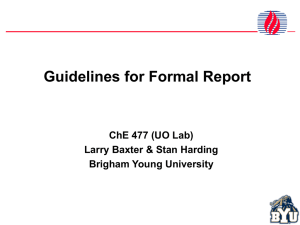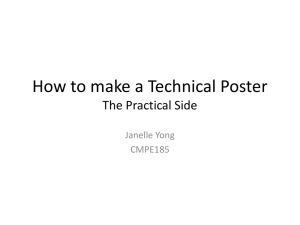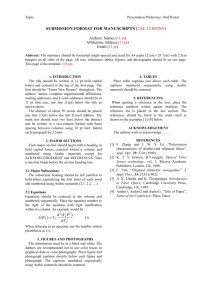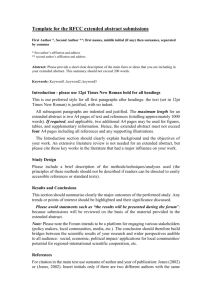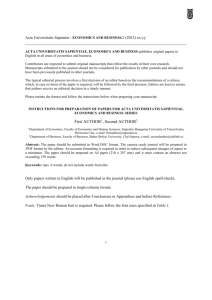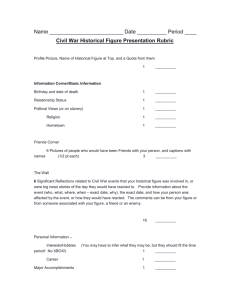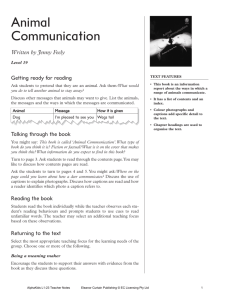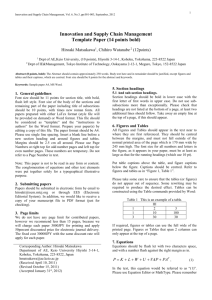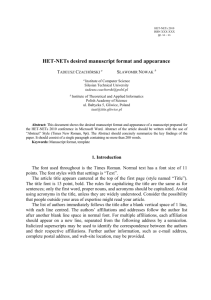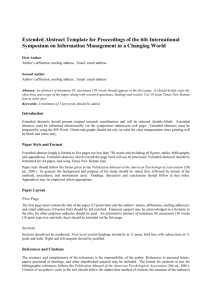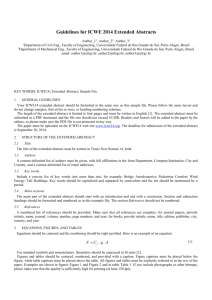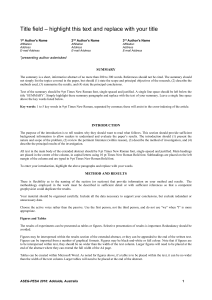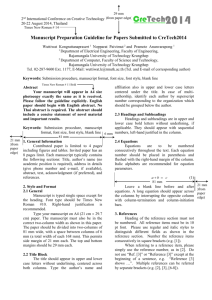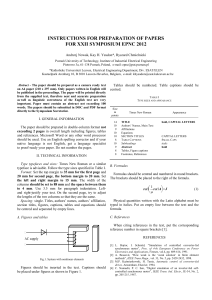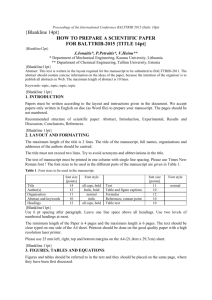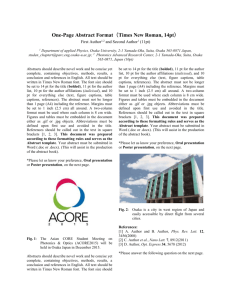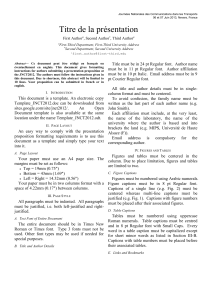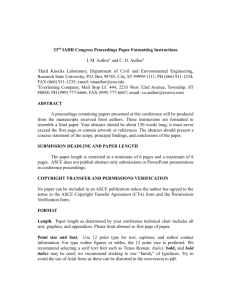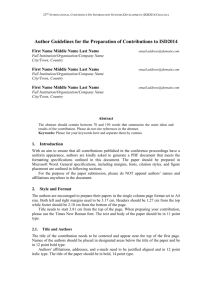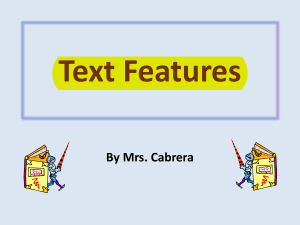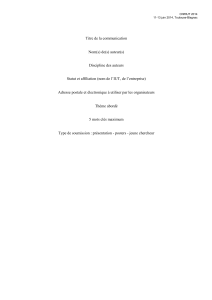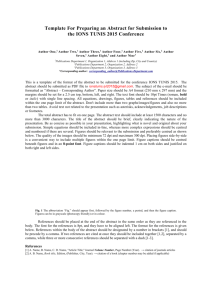here - IWCEA 2015
advertisement
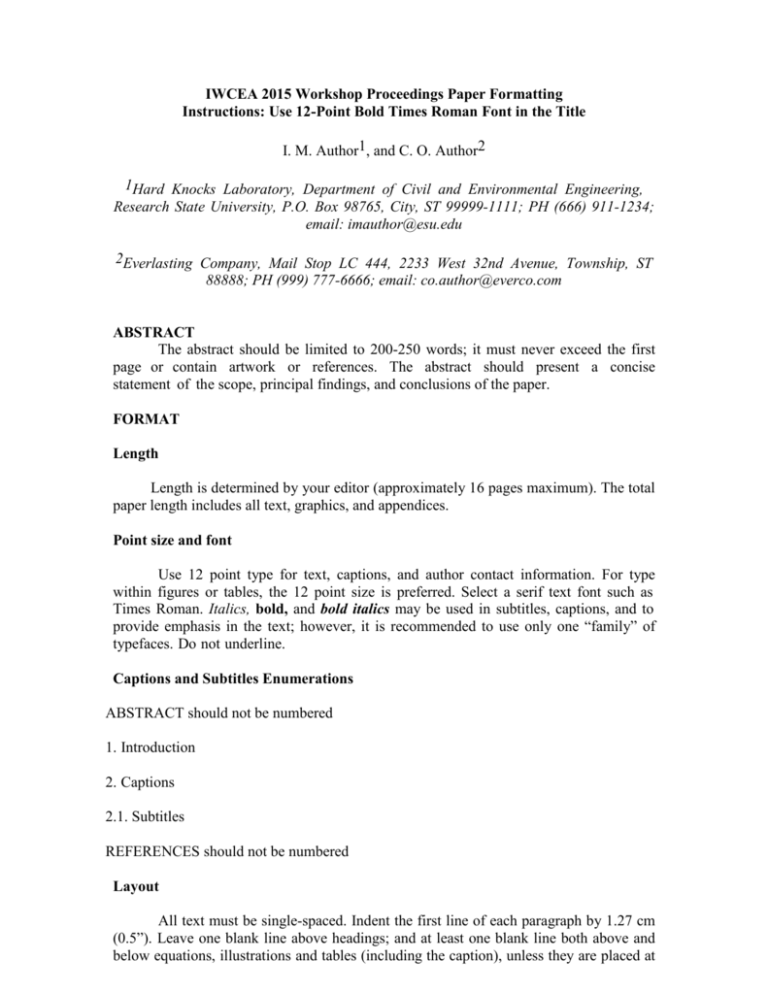
IWCEA 2015 Workshop Proceedings Paper Formatting Instructions: Use 12-Point Bold Times Roman Font in the Title I. M. Author1, and C. O. Author2 1Hard Knocks Laboratory, Department of Civil and Environmental Engineering, Research State University, P.O. Box 98765, City, ST 99999-1111; PH (666) 911-1234; email: imauthor@esu.edu 2Everlasting Company, Mail Stop LC 444, 2233 West 32nd Avenue, Township, ST 88888; PH (999) 777-6666; email: co.author@everco.com ABSTRACT The abstract should be limited to 200-250 words; it must never exceed the first page or contain artwork or references. The abstract should present a concise statement of the scope, principal findings, and conclusions of the paper. FORMAT Length Length is determined by your editor (approximately 16 pages maximum). The total paper length includes all text, graphics, and appendices. Point size and font Use 12 point type for text, captions, and author contact information. For type within figures or tables, the 12 point size is preferred. Select a serif text font such as Times Roman. Italics, bold, and bold italics may be used in subtitles, captions, and to provide emphasis in the text; however, it is recommended to use only one “family” of typefaces. Do not underline. Captions and Subtitles Enumerations ABSTRACT should not be numbered 1. Introduction 2. Captions 2.1. Subtitles REFERENCES should not be numbered Layout All text must be single-spaced. Indent the first line of each paragraph by 1.27 cm (0.5”). Leave one blank line above headings; and at least one blank line both above and below equations, illustrations and tables (including the caption), unless they are placed at the top or bottom of the page. Page design should be consistent throughout the paper. Margin settings The text area must contain all elements of the paper that will be reproduced (text, figures, tables, captions). (Table 1 summarizes the margin settings for the Letter and A4 size pages). Table 1. Margin settings for International A4 size pages Margins Top Bottom Left Right International A4 size page (21 cm × 29.7 cm) 2.50 cm 2.50 cm 2.50 cm 2.50 cm Figures and tables All graphics (photos, line art, and tables) must be embedded centered in the text All graphics should be understandable when printed in black and white. Do not use only color as a distinguishing feature. Use symbols or patterns on line and bar graphs to identify lines and columns. Landscape orientation is acceptable. Numbering. Illustrations should be numbered consecutively as they are presented (Figure 1, Figure 2, etc., and Table 1, Table 2, etc.). Each figure should be mentioned or “called out” before it appears. More than one figure may appear on a page. Captions and legends. A descriptive caption, including figure number, should be placed directly below the illustration (see Figure 1). A descriptive legend, including table number, should be placed immediately above the table (see Table 1). Placement. Figures may be placed in the text. More than one figure may appear on a page. Style The paper must be written in the best possible technical and grammatical English. Titles should be concise and should describe the content of the paper. If you have a long title, please consider a Title: Subtitle format, for example: Problematic Soil Characterization: Lessons Learned from Foundation Failures in Expansive Soils Mathematics All mathematics must be embedded centered in the text using an equation editor. Equations need to be numbered only if they are referred to more than once. Figure 1. Sample line art illustration. System of units Authors must use the International System of Units (SI), and units acceptable in SI. Alternatively, dual units can be provided with SI given first and corresponding English Imperial units given in parentheses. For more information about SI units, go to the U.S. Metric Association (USMA), Inc. site (http://lamar.colostate.edu/~hillger/) or the National Institute of Standards and Technology (NIST) site (http://physics.nist.gov/cuu/Units/index.html). Author contact information A sample of author contact information is shown on the first page of these instructions. The following information may be provided for all authors of the paper: author’s full name; Society membership grade; academic degrees or honorifics; current employment affiliation; postal and electronic mailing addresses; phone number. References All references should appear together at the end of the paper. References are listed alphabetically by last name of the first author. When two or more references by the same author are listed, year of publication is taken into account, and the earliest work is listed first. Wherever reference is made in the text to an author’s work, the author’s surname and year of publication should appear in parentheses. Superscripts shall not be used to denote references, as these numbers often appear too small to be read easily. All listed references must be cited in text.. REFERENCES Becker, D.E., Crooks, J.H.A., Been, K., and Jefferies, M.G. (1987). "Work as a criterion for determining in-situ and yield stresses in clays." Canadian Geotech. J. 24 (4): 549-564. Berre, T. and Bjerrum, L. (1973). "Shear strength of normally consolidated clays." Proc. 8th Intl. Conference on Soil Mechanics and Foundation Engrg., Vol. 1.1, Moscow: 39-49. Bruce, D.A. (2005). "Glossary of grouting terminology." J. Geotechnical and Geoenvironmental Engrg. 131 (12): 1534-1542. Camp, W.M. (2004). "Drilled and driven foundation behavior in a calcareous clay." GeoSupport 2004, GSP No. 124, ASCE, Reston/VA: 1-18. Campanella, R.G. and Robertson, P.K. (1988). "Current status of the piezocone test." Penetration Testing 1988, Vol. 1, Balkema, Rotterdam: 93-116. Germaine, J.T. (1982). Development of the directional shear cell for measuring crossanisotropic clay properties. ScD Thesis, Dept. of Civil Engineering, MIT, Cambridge, Mass, 569 p. .. .. Tamrakar, S. B., Mitachi, T., Toyosawa, Y., and Itoh, K. (2005). "Development of a new soil tensile test apparatus." Proc., Geo-Frontiers 2005, Site Characterization and Modeling, Geotechnical Special Publication 138 (CD-ROM), ASCE, Reston, VA.
